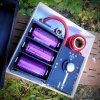RedEye, I would love to know, in general, what you learn about temp sensing. It's understood that implementation details might be "IP" you don't want to share.
From all the theory without details above I'm assuming that no one has seen truly functional temp sensing with a VC. I'm strong on the software side so the PID part is straightforward (there are plenty of sample libraries that can be used). The trick is the sensing, without good data you can't do anything useful...
You're right on point - the trick is getting fast, accurate reads on a vapcap. I haven't even begun to start testing the IR module yet. I'm still working on tooling and some additional setup to do anything useful with it. It will be some time before I have any results worth a damn. I fully expect to get down and dirty with it, but I don't wanna start with my eye(s) closed
 I am intrigued by the idea of the use of silicone for heat control in the heater's oven cavity. This could be suitable material for testing in conjunction with the sensor and is one of the things I'll be taking a further look into. I need to (a) bake the sensor programming and libs into my code, (b) get a suitable testing rig designed to start collecting data, (c) do a lot of math to "right-size" the implementation.
I am intrigued by the idea of the use of silicone for heat control in the heater's oven cavity. This could be suitable material for testing in conjunction with the sensor and is one of the things I'll be taking a further look into. I need to (a) bake the sensor programming and libs into my code, (b) get a suitable testing rig designed to start collecting data, (c) do a lot of math to "right-size" the implementation. Of course, this is all on top of being able to accurately control the heater itself, too. Even if you can read the cap in 100ths or 10ths and PID tune the heater, you still need a way for the controller to accurately gauge how much power it's really putting out and where it's coasting to, to hit the desired temp and then stabilize. It's rather challenging because historically, the vapcap click relies on thermal overshoot (torch, and fast IH) to get to the proper running temp. Since we're not exceeding those temps in a controlled IH (observed), we need to be far more precise with how much power is applied for how long. And when to regulate it. And how to present that control and setting to a user in a meaningful, easy way. THEN "user harden" it.
It's not just a "read the temp and call it good" thing, there are a ton of invisible moving parts from a thermal perspective that must be accounted for and balanced on split second timing, and I think that's the real challenge. Lots of interesting projects on this floating around!















